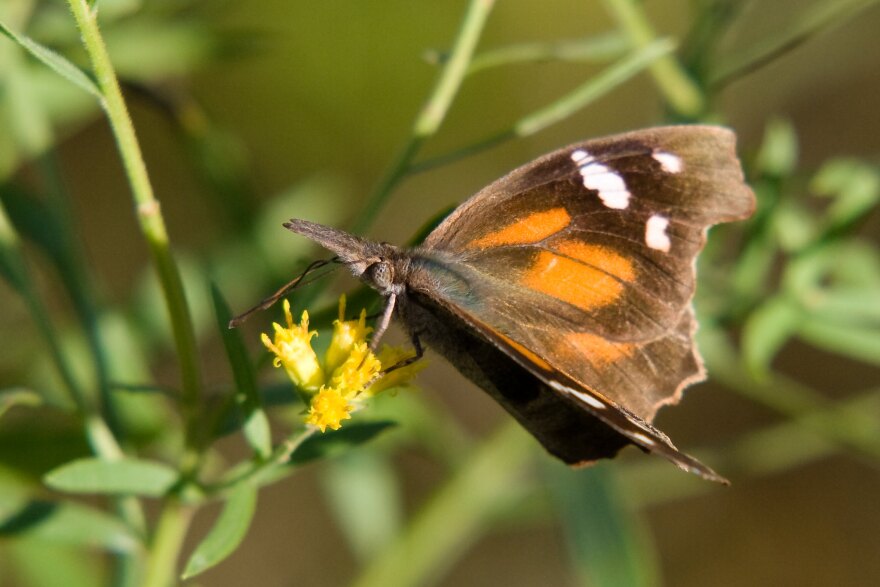While the iconic monarch butterfly may have dwindling numbers due to climate change and habitat loss, other butterflies are thriving in Texas. People in the central and southern part of the state have likely noticed a small, brown and orange butterfly out in force recently: American Snout butterflies have been taking to the skies – and, if you’ve been on the freeway, perhaps splattering across your windshield.
The insects emerge annually, according to Molly Keck, Texas A&M University AgriLife extension entomologist, and their numbers are influenced by climate patterns throughout the year. And although it may seem like a large swarm, this year’s emergence was relatively small compared to other years.
This transcript has been edited lightly for clarity:
Texas Standard: These snout-nosed butterflies seemed to come out of nowhere last week, and then they were gone almost as quickly as they appeared. Where did they come from? Is this part of the migration like we see with monarchs?
Molly Keck: It’s not an actual migration. They’re not going in a directional pattern anywhere. So it’s just a mass emergence that we see every year. I typically say it’s around Labor Day, and that’s kind of exactly when it happened this year, and some years you just see many more of them than you do in other years. This was a pretty mild year. We’ve had years where they persist for weeks and weeks, just emerging and emerging, and it takes forever before you can feel like it’s safe to actually wash your car. But this year was a pretty mild one as things go.
So what accounts in the differences? What makes a good snout-nose butterfly year versus a bad snout-nose butterfly year?
It really depends on weather, and it can be one of two different weather patterns. Typically, it’s because we have had a lot of rain in the springtime, maybe even through the summer and so their primary food source, which is the hackberry plant. A lot of people are familiar with hackberry trees, but there’s also bushes and other kind of shrub-like material that they tend to feed on. So when there’s lots of water, then there’s lots of leaves that are pushed out of those plants, lots of food sources for the larva to feed on. And as a result, many of them survive to make it to adulthood around this time of year.
And then in some years – which is what I was wondering if we were going to see this year – it’s an extended period of drought that allows all of their predators to not survive, and so more of the larvae make it to adulthood. But we didn’t really see that. We just kind of saw what we what we typically see.
And what niche do they fill in in the ecosystem? Why do we need stout-nose butterflies?
Well, they play a role somewhere. They’re a food source for birds, for lizards and other things that prey on caterpillars. You know, it was a really, really dry summer, and so a lot of these predators and these important animals had very few food sources. So seeing a lot of these makes me feel better about how they fared. They’re also somewhat of a pollinator. Butterflies, by and large, are not fabulous pollinators because they’re attracted to nectar and not the actual pollen – so they don’t really get a lot of that on their body, but they do their fair share.
And when you see years like we’ve had in the past, where there’s just, you know, trillions of these butterflies, and you have to imagine that they’re doing something, they’re doing some significant pollinating. So they’re pollinators and they’re an important food source for small predators in their larval form as a caterpillar.
What is the conservation status of these butterflies? A lot of these guys end up on windshields and car grilles, unfortunately. If you’re a driver and you hit one, should you feel guilty, or are there a ton of them flying around out there?
There are plenty of them. We’re going to see another emergence of them next year around this time. You shouldn’t feel too bad about it. There is no conservation status as far as if they’re endangered or even somewhat close to it. They’re not even on the radar. You may not like smashing them, but I’ve typically found that there’s a good window of speed. If you go slow enough, then they just kind of blow past you. And if you go fast enough on the highway, then they kind of fly over your car. But there’s a sweet spot where they just can’t get out of your way and the wind doesn’t blow them out of the way.
So what is that, about 80-85 mph, do you think?
No, I’d say more like in the 40s, something like that, like a typical on-the-road type of a driving, which most people do.
We’re not seeing them as as much right now. There are pockets, at least in my area in Bexar County, where they’re still pretty hot and heavy. And that probably has to do with the fact that there’s hackberry is around. But I’m just telling people, give it another week before you go to the car wash, because you might you may regret it.
If you found the reporting above valuable, please consider making a donation to support it here. Your gift helps pay for everything you find on texasstandard.org and KUT.org. Thanks for donating today.

